The competitive landscape of the US Radar Transmitter Market is marked by a dynamic interplay of innovation, technology advancement, and strategic positioning among leading players. This market serves various sectors, including defense, aerospace, and commercial applications, establishing a gateway for continuous growth and competition. Companies are heavily investing in research and development activities to enhance their product offerings and cater to the rising demand for advanced radar systems.
The market is characterized by a mix of established firms and emerging players, each vying to capture market share through unique value propositions, cutting-edge technology, and customer focus, which collectively shape the competitive environment. Lockheed Martin stands as a formidable player in the US Radar Transmitter Market, leveraging its extensive experience in aerospace and defense sectors. With a strong emphasis on developing innovative radar systems, Lockheed Martin focuses on providing advanced solutions that meet stringent military and civilian requirements.
The company's strengths lie in its robust research and development capabilities, enabling it to introduce state-of-the-art technologies that enhance radar performance and reliability. Lockheed Martin's strategic partnerships and collaborations with government entities bolster its market presence, allowing for a comprehensive understanding of customer needs and tailored solutions. This alignment with key defense programs positions Lockheed Martin as a preferred vendor within the radar transmitter landscape, ensuring competitive advantage and continued relevance in a rapidly evolving market.
General Dynamics, another key player in the US Radar Transmitter Market, focuses on delivering high-performance radar systems that cater to both military and commercial applications. The company has established itself as a leader through a suite of innovative products designed to improve situational awareness and target detection capabilities. General Dynamics capitalizes on its strong engineering expertise and decades of industry experience, which translates into reliability and quality in its radar offerings. Its strategic initiatives, including mergers and acquisitions, have strengthened its market position by expanding its technological capabilities and broadening its portfolio.
By continuously enhancing its product lines and engaging in strategic collaborations, General Dynamics sustains its competitive edge in the US market, reflecting a strong commitment to serving the evolving needs of its customers in defense and beyond.






















